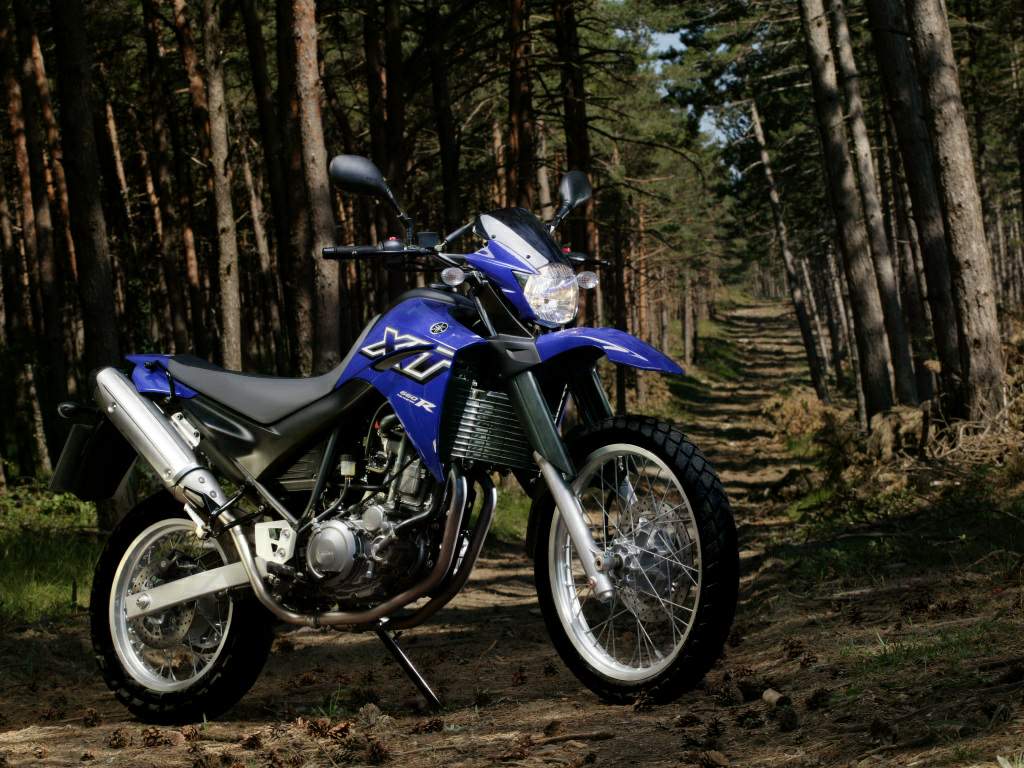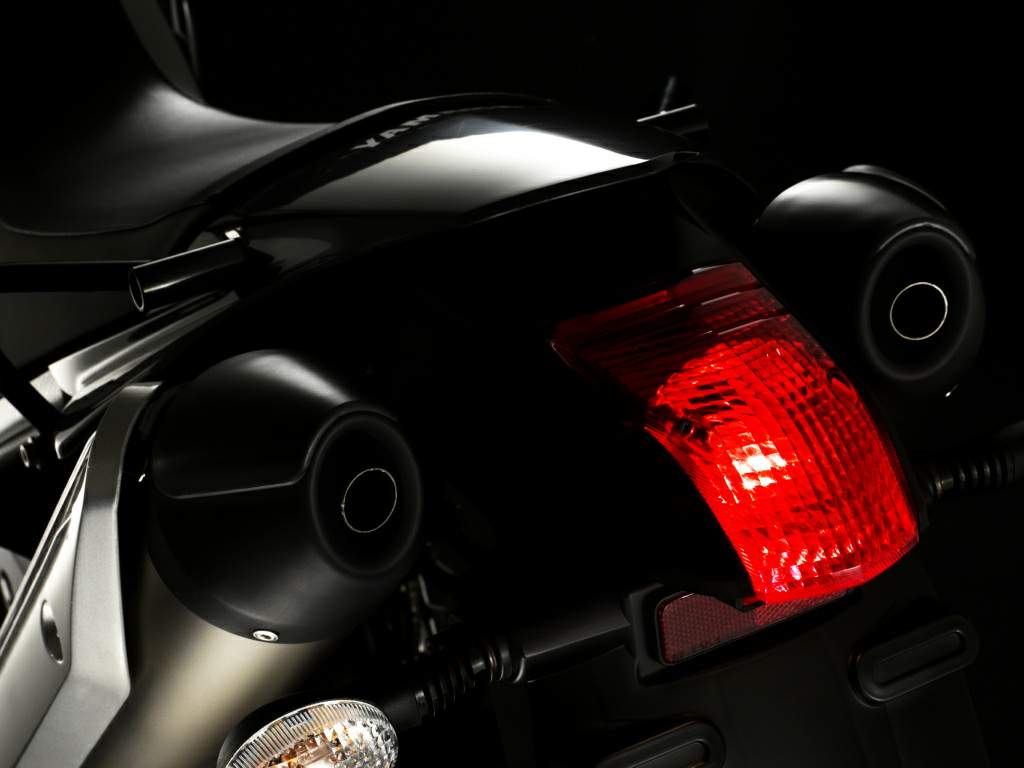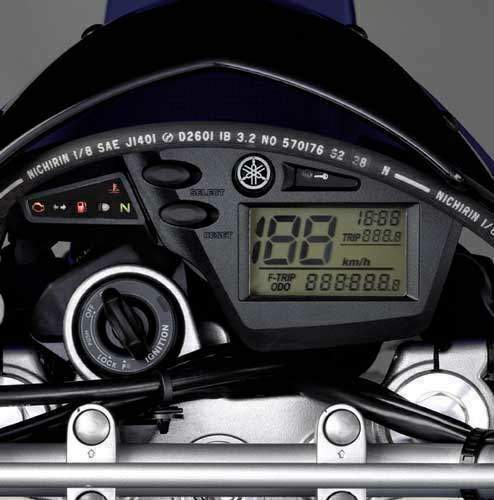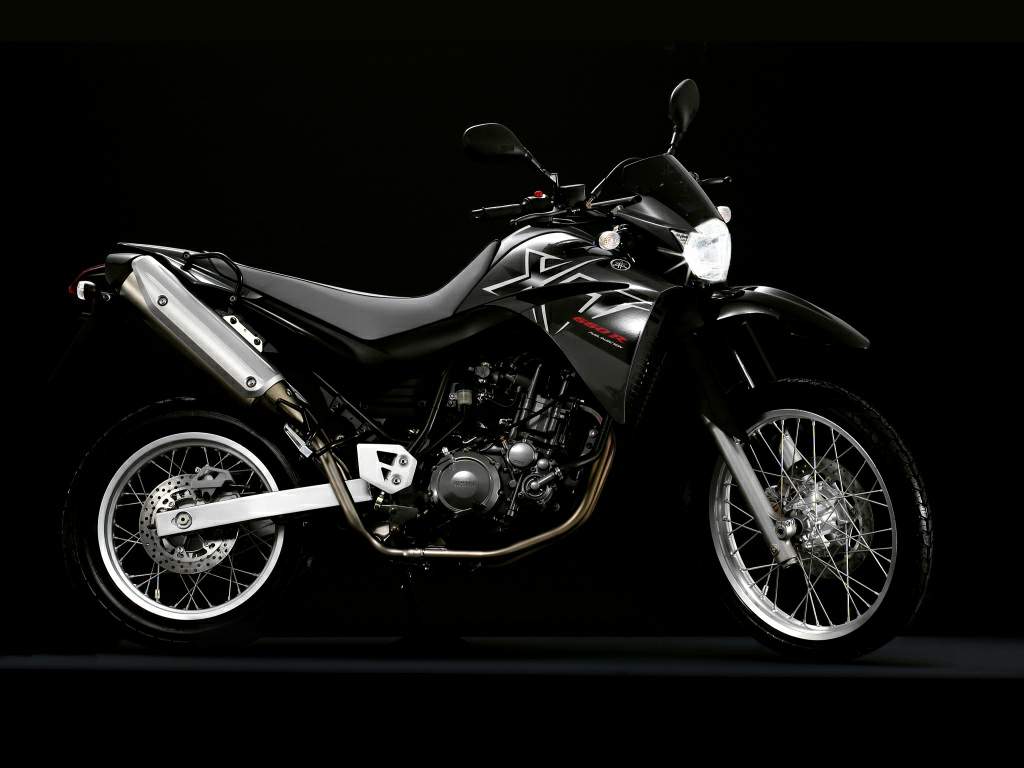| . |
|
Make Model |
Yamaha XT660R |
|
Year |
2005 |
|
Engine |
Four stroke, single cylinder, SOHC, 4 valve |
|
Capacity |
659 cc/ 40.2 cu-in |
| Bore x Stroke | 100 x 84 mm |
| Compression Ratio | 10.0: 1 |
| Cooling System | Liquid cooled |
|
Induction |
Fuel injection, 44 mm throttle body |
| Lubrication | Dry sump |
| Oil Capacity | 2.9 Litres / 0.19 quarts |
|
Ignition |
TCI |
| Starting | Electric |
|
Max Power |
33.8 kW / 48 hp @ 6000 rpm |
|
Max Torque |
58.4 Nm / 5.7 kgf-m @ 5250 rpm |
| Clutch | Wet, multiple-disc coil spring |
|
Transmission |
5 Speed |
| Final Drive | Chain |
| Frame | Steel tubular diamond frame with dual tank rails |
|
Front Suspension |
43 mm Telescopic forks, |
| Front Wheel Travel | 225 mm / 8.8 in |
|
Rear Suspension |
Oscillating arm standard Monocross. 200mm wheel travel |
| Rear Wheel Travel | 200 mm / 7.9 in |
|
Front Brakes |
Single 298mm disc 2 piston caliper |
|
Rear Brakes |
Single 245mm disc 1 piston caliper |
|
Front Tyre |
90/90- 21 |
|
Rear Tyre |
130/80–17 |
| Rake | 27.0° |
| Trail | 107 mm / 4.2 in |
| Dimensions |
Height 1230 mm / 48.4 in Length 2240 mm / 88.1 in Width 845 mm / 33.2 in |
| Wheelbase | 1505 mm / 59.3 in |
| Ground Clearance | 210 mm / 8.3 in |
| Seat Height | 865mm / 34.1 in |
| Dry Wight | 172 kg / 379.2 lbs |
|
Wet Weight |
181 kg / 421 lbs |
|
Fuel Capacity |
15 Litres / 3.3 US gal |
|
Consumption Average |
23 km/lit |
|
Standing ¼ Mile |
14.2 sec |
|
Top Speed |
164.7 km/h / 102.3 mph |
| . |
Remember the days when manly men rode XT's? Almost three long decades ago Yamaha launched the XT500 and the model would grow to become the inspiration source for countless variations on the rough-and-macho dual-purpose theme. You could almost say that the whole cult of adventure sports started with this model. People rode XTs -- -500s, -550s and -600s -- across deserts and trails, raced them (mainly in their TT guise) or simply set about crossing Australia or Patagonia on one, tent and sleeping bag strapped to a sturdy rack.
With the raise in importance of the Paris-Dakar race, parking a "Ténéré" (the so-called 'race replica' version with its 7.5 gallon gas tank) in front of a bar or coffee shop in Paris was a proven method to get the chicks, especially if you wore a color-matched off-road jacket lightly spotted with mud stains. Just how big an impact the XT series had at the time can be judged from the fact that for quite a few years, the XT600 used to top European sales hit parades. Gee, how times have changed.

Green parties, angry environmentalists and all the rest of the good-willed gang, have limited access to off-road playing grounds drastically. Much like current SUVs, today's crop of DPs are far more functional objects that offer a comfy and erect riding position, perfect for relaxed touring and light exploring rather than being proper off-road tackle. So Yamaha's first redo of the long-running XT series in more than a decade has to deal with a very different world, and it shows.
The tall and lean off-road stance is all there, ditto for the longish suspenders (that any XT500 owner would have sold his sister for), but any serious dirt person would spot the low-slung exhaust pipes, the huge silencers and the almost overly designed body work that shout style above function. It's hard to blame Yamaha alone on this softening of image. Have a look at current DPs -- like Suzuki's V-Strom 650 or BMW's F650 -- and the shift towards road-only work and worldly comforts is evident. Seen in that light, the new XT660R emerges, at least initially, as the (still) more off-road oriented of the current DP crop. Yes, today's real macho men ride KTM Adventures or XR650Rs, but these are full-on desert racers with very little disposition for everyday road work.

Technically speaking the XT660R is a mixture of mainly new and a bit of old. If the number 660 sounds familiar to some then its because in the 90's Yamaha offered a "Super XT" in the shape of the Europe-only, five-valve, water-cooled XTZ660 which also had a full Paris-Dakar style body work with an integral fairing for comfy 100mph flying over dry lakes. Surprisingly, the new 660s top end is all new and the engine reverts to four valves while still being water cooled. Another big change is the new electronic fuel injection system that together with the twin catalytic converters allows the XT to survive in the green third millennium.
I said "old and new" and the reason is that as new as the top end is, I wouldn't be surprised if the XT's engine cases mounting bosses would fit straight into an 80's XT frame. Case side covers have a suitable new design, but it's hard not to spot the all-too-familiar crankcases sandwiched between them. Claimed horsepower for this mill is 48 horsies, about even with an F650. After decades of closed loop frames in the XT family, the new model gets an open cradle job with the engine cases serving as a stressed member, another sign that the XT isn't really conceived to handle 20 foot drop-offs. A 43mm Paioli right-way-up fork handles front suspension chores while at the back a standard looking rectangular section swingarm is connected to the shock via a progressive link.
Remember the days when manly men rode XT's? Almost three long decades ago Yamaha launched the XT500 and the model would grow to become the inspiration source for countless variations on the rough-and-macho dual-purpose theme. You could almost say that the whole cult of adventure sports started with this model. People rode XTs -- -500s, -550s and -600s -- across deserts and trails, raced them (mainly in their TT guise) or simply set about crossing Australia or Patagonia on one, tent and sleeping bag strapped to a sturdy rack.
With the raise in importance of the Paris-Dakar race, parking a "Ténéré" (the so-called 'race replica' version with its 7.5 gallon gas tank) in front of a bar or coffee shop in Paris was a proven method to get the chicks, especially if you wore a color-matched off-road jacket lightly spotted with mud stains. Just how big an impact the XT series had at the time can be judged from the fact that for quite a few years, the XT600 used to top European sales hit parades. Gee, how times have changed.

Green parties, angry environmentalists and all the rest of the good-willed gang, have limited access to off-road playing grounds drastically. Much like current SUVs, today's crop of DPs are far more functional objects that offer a comfy and erect riding position, perfect for relaxed touring and light exploring rather than being proper off-road tackle. So Yamaha's first redo of the long-running XT series in more than a decade has to deal with a very different world, and it shows.
The tall and lean off-road stance is all there, ditto for the longish suspenders (that any XT500 owner would have sold his sister for), but any serious dirt person would spot the low-slung exhaust pipes, the huge silencers and the almost overly designed body work that shout style above function. It's hard to blame Yamaha alone on this softening of image. Have a look at current DPs -- like Suzuki's V-Strom 650 or BMW's F650 -- and the shift towards road-only work and worldly comforts is evident. Seen in that light, the new XT660R emerges, at least initially, as the (still) more off-road oriented of the current DP crop. Yes, today's real macho men ride KTM Adventures or XR650Rs, but these are full-on desert racers with very little disposition for everyday road work.
Technically speaking the XT660R is a mixture of mainly new and a bit of old. If the number 660 sounds familiar to some then its because in the 90's Yamaha offered a "Super XT" in the shape of the Europe-only, five-valve, water-cooled XTZ660 which also had a full Paris-Dakar style body work with an integral fairing for comfy 100mph flying over dry lakes. Surprisingly, the new 660s top end is all new and the engine reverts to four valves while still being water cooled. Another big change is the new electronic fuel injection system that together with the twin catalytic converters allows the XT to survive in the green third millennium.
I said "old and new" and the reason is that as new as the top end is, I wouldn't be surprised if the XT's engine cases mounting bosses would fit straight into an 80's XT frame. Case side covers have a suitable new design, but it's hard not to spot the all-too-familiar crankcases sandwiched between them. Claimed horsepower for this mill is 48 horsies, about even with an F650. After decades of closed loop frames in the XT family, the new model gets an open cradle job with the engine cases serving as a stressed member, another sign that the XT isn't really conceived to handle 20 foot drop-offs. A 43mm Paioli right-way-up fork handles front suspension chores while at the back a standard looking rectangular section swingarm is connected to the shock via a progressive link.
Source Motorcycle.com

